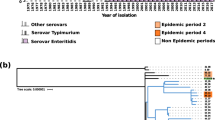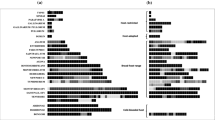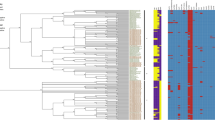Abstract
Salmonella Dublin is a strongly adapted serovar that causes enteritis and/or systemic disease with high rates of mortality in cattle and occasionally infects humans. Despite the importance of this serovar, there is a lack of studies in Brazil. The aim of this study was to characterize the genetic diversity of 112 S. Dublin strains isolated from humans and animals in Brazil by CRISPR and CRISPR-MVLST and the relatedness among strains by MLST. In addition, the frequency of some important virulence genes was verified. The strains studied belonged to nine different sequence types, being all of them single- or double-locus variants of the ST10. CRISPR discriminated the strains into 69 subtypes with a similarity ≥ 84.4% and CRISPR-MVLST into 72 subtypes with a similarity ≥ 84.7%. The virulence genes ratB, lpfA, mgtC, avrA, sopB, sopE2, sifA, sseA, ssrA, csgA, fliC, and sinH were found in all the strains studied, while spvB, spvC, sodCl, rpoS, sipA, sipD, invA, and hilA were detected in ≥ 93.7% of the strains. In conclusion, the high similarity among the strains reinforces the clonal nature of the strains of this serovar that may have descended from a common ancestor that little differed over 33 years in Brazil. CRISPR and CRISPR-MVLST showed to be good alternatives to type S. Dublin strains. MLST suggested that S. Dublin strains from Brazil were phylogenetically related to strains from other parts of the globe. Moreover, the high frequency of virulence genes among the strains studied reinforces the capacity of S. Dublin to cause invasive diseases.





Similar content being viewed by others
References
Majowicz SE, Musto J, Scallan E, Angulo FJ, Kirk M, O'Brien SJ, Jones TF, Fazil A, Hoekstra RM (2010) The global burden of nontyphoidal Salmonella gastroenteritis. Clin Infect Dis 50:882–889. https://doi.org/10.1086/650733
Uzzau S, Brown DJ, Wallis T, Rubino S, Leori G, Bernard S, Casadesús J, Platt DJ, Olsen JE (2000) Host adapted serotypes of Salmonella enterica. Epidemiol Infect 125:229–255
Nielsen LR (2013) Review of pathogenesis and diagnostic methods of immediate relevance for epidemiology and control of Salmonella Dublin in cattle. Vet Microbiol 162:1–9. https://doi.org/10.1016/j.vetmic.2012.08.003
Pezoa D, Blondel CJ, Silva CA, Yang HJ, Andrews-Polymenis H, Santiviago CA, Contreras I (2014) Only one of the two type VI secretion systems encoded in the Salmonella enterica serotype Dublin genome is involved in colonization of the avian and murine hosts. Vet Res 45:2–2. https://doi.org/10.1186/1297-9716-45-2
Hur J, Choi YY, Park JH, Jeon BW, Lee HS, Kim AR, Lee JH (2011) Antimicrobial resistance, virulence-associated genes, and pulsed-field gel electrophoresis profiles of Salmonella enterica subsp. enterica serovar Typhimurium isolated from piglets with diarrhea in Korea. Can J Vet Res 75:49–56
Shah DH, Zhou X, Addwebi T, Davis MA, Orfe L, Call DR, Guard J, Besser TE (2011) Cell invasion of poultry-associated Salmonella enterica serovar Enteritidis isolates is associated with pathogenicity, motility and proteins secreted by the type III secretion system. Microbiol 157:1428–1445. https://doi.org/10.1099/mic.0.044461-0
Zou M, Keelara S, Thakur S (2012) Molecular characterization of Salmonella enterica serotype Enteritidis isolates from humans by antimicrobial resistance, virulence genes, and pulsed-field gel electrophoresis. Foodborne Pathog Dis 9:232–238. https://doi.org/10.1089/fpd.2011.1012
Suez J, Porwollik S, Dagan A, Marzel A, Schorr YI, Desai PT, Agmon V, McClelland M, Rahav G, Gal-Mor O (2013) Virulence gene profiling and pathogenicity characterization of non-typhoidal Salmonella accounted for invasive disease in humans. PLoS One 8:e58449–e58449. https://doi.org/10.1371/journal.pone.0058449
Liebana E, Garcia-Migura L, Clouting C, Cassar CA, Clifton-Hadley FA, Lindsay EA, Threlfall EJ, Chappell SA, Davies RH (2002) Investigation of the genetic diversity among isolates of Salmonella enterica serovar Dublin from animals and humans from England, Wales and Ireland. J Appl Microbiol 93:732–744. https://doi.org/10.1046/j.1365-2672.2002.01737.x
Zhao S, McDermott PF, White DG, Qaiyumi S, Friedman SL, Abbott JW, Glenn A, Ayers SL, Post KW, Fales WH, Wilson RB, Reggiardo C, Walker RD (2007) Characterization of multidrug resistant Salmonella recovered from diseased animals. Vet Microbiol 123:122–132. https://doi.org/10.1016/j.vetmic.2007.03.001
Kjeldsen MK, Torpdahl M, Campos J, Pedersen K, Nielsen EM (2014) Multiple-locus variable-number tandem repeat analysis of Salmonella enterica subsp. enterica serovar Dublin. J Appl Microbiol 116:1044–1054. https://doi.org/10.1111/jam.12441
Vignaud ML, Cherchame E, Marault M, Chaing E, Le Hello S, Michel V, Jourdan-Da Silva N, Lailler R, Brisabois A, Cadel-Six S (2017) MLVA for Salmonella enterica subsp. enterica Serovar Dublin: development of a method suitable for inter-laboratory surveillance and application in the context of a raw milk cheese outbreak in France in 2012. Front Microbiol 8:295. https://doi.org/10.3389/fmicb.2017.00295
Vilela FP, Frazão MR, Rodrigues DP, Costa RG, Casas MRT, Fernandes SA, Falcão JP, Campioni F (2018) Genetic diversity, anti-microbial resistance, plasmid profile and frequency of the Vi antigen in Salmonella Dublin strains isolated in Brazil. Zoonoses Public Health 65:e34–e43. https://doi.org/10.1111/zph.12407
Litrup E, Torpdahl M, Malorny B, Huehn S, Christensen H, Nielsen EM (2010) Association between phylogeny, virulence potential and serovars of Salmonella enterica. Infect Genet Evol 10:1132–1139. https://doi.org/10.1016/j.meegid.2010.07.015
Achtman M, Wain J, Weill FX, Nair S, Zhou Z, Sangal V, Krauland MG, Hale JL, Harbottle H, Uesbeck A, Dougan G, Harrison LH, Brisse S, the S.e.M.s.g (2012) Multilocus sequence typing as a replacement for serotyping in Salmonella enterica. PLoS Pathog 8:e1002776. https://doi.org/10.1371/journal.ppat.1002776
Yim L, Sasías S, Martínez A, Betancor L, Estevez V, Scavone P, Bielli A, Sirok A, Chabalgoity JA (2014) Repression of flagella is a common trait in field isolates of Salmonella enterica Serovar Dublin and is associated with invasive human infections. Infect Immun 82:1465–1476. https://doi.org/10.1128/IAI.01336-13
Silva C, Betancor L, García C, Astocondor L, Hinostroza N, Bisio J, Rivera J, Perezgasga L, Pérez Escanda V, Yim L, Jacobs J, García-Del Portillo F, SalmoIber CN, Chabalgoity JA, Puente JL (2017) Characterization of Salmonella enterica isolates causing bacteremia in Lima, Peru, using multiple typing methods. PLoS One 12:e0189946–e0189946. https://doi.org/10.1371/journal.pone.0189946
Almeida F, Medeiros MIC, Rodrigues DDP, Allard MW, Falcão JP (2017a) Molecular characterization of Salmonella typhimurium isolated in Brazil by CRISPR-MVLST. J Microbiol Methods 133:55–61. https://doi.org/10.1016/j.mimet.2016.12.020
Almeida F, Seribelli AA, Silva P, Medeiros MIC, Rodrigues DDP, Moreira CG, Allard MW, Falcão JP (2017b) Multilocus sequence typing of Salmonella Typhimurium reveals the presence of the highly invasive ST313 in Brazil. Infect Genet Evol 51:41–44. https://doi.org/10.1016/j.meegid.2017.03.009
Campioni F, Pitondo-Silva A, Bergamini AM, Falcão JP (2015) Comparison of four molecular methods to type Salmonella Enteritidis strains. APMIS 123:422–426. https://doi.org/10.1111/apm.12367
Horvath P, Barrangou R (2010) CRISPR/Cas, the immune system of bacteria and archaea. Science 327:167–1412. https://doi.org/10.1128/JB.01415-07
Touchon M, Rocha EPC (2010) The small, slow and specialized CRISPR and anti-CRISPR of Escherichia and Salmonella. PLoS One 5:e11126. https://doi.org/10.1371/journal.pone.0011126
Shariat N, DiMarzio MJ, Yin S, Dettinger L, Sandt CH, Lute JR, Barrangou R, Dudley EG (2013) The combination of CRISPR-MVLST and PFGE provides increased discriminatory power for differentiating human clinical isolates of Salmonella enterica subsp. enterica serovar Enteritidis. Food Microbiol 34:164–173. https://doi.org/10.1016/j.fm.2012.11.012
Shariat N, Kirchner MK, Sandt CH, Trees E, Barrangou R, Dudley EG (2013) Subtyping of Salmonella enterica Serovar Newport outbreak isolates by CRISPR-MVLST and determination of the relationship between CRISPR-MVLST and PFGE results. J Clin Microbiol 51:2328–2336. https://doi.org/10.1128/JCM.00608-13
Deng X, Shariat N, Driebe EM, Roe CC, Tolar B, Trees E, Keim P, Zhang W, Dudley EG, Fields PI, Engelthaler DM (2015) Comparative analysis of subtyping methods against a whole-genome-sequencing standard for Salmonella enterica serotype Enteritidis. J Clin Microbiol 53:212–218. https://doi.org/10.1128/JCM.02332-14
Rytkönen A, Poh J, Garmendia J, Boyle C, Thompson A, Liu M, Freemont P, Hinton JCD, Holden DW (2007) SseL, a Salmonella deubiquitinase required for macrophage killing and virulence. PNAS USA 104:3502–3507. https://doi.org/10.1073/pnas.0610095104
Kisiela D, Laskowska A, Sapeta A, Kuczkowski M, Wieliczko A, Ugorski M (2006) Functional characterization of the FimH adhesin from Salmonella enterica serovar Enteritidis. Microbiol 152:1337–1346. https://doi.org/10.1099/mic.0.28588-0
Liu F, Barrangou R, Gerner-Smidt P, Ribot EM, Knabel SJ, Dudley EG (2011) Novel virulence gene and clustered regularly interspaced short palindromic repeat (CRISPR) multilocus sequence typing scheme for subtyping of the major Serovars of Salmonella enterica subsp. enterica. Appl Environ Microbiol 77:1946–1956. https://doi.org/10.1128/AEM.02625-10
Olsen JE, Skov M (1994) Genomic lineage of Salmonella enterica serovar Dublin. Vet Microbiol 40:271–282. https://doi.org/10.1016/0378-1135(94)90116-3
FAd C, VRd S, Martins CHG, Fernandes SA, Zaia JE, Martinez R (2002) Prevalence and antimicrobial susceptibility of Salmonella serotypes in patients from Ribeirão Preto, São Paulo, Brazil, between 1985 and 1999. Braz J Infect Dis 6:244–251. https://doi.org/10.1590/S1413-86702002000500005
Tavechio AT, Ghilardi ÂCR, Peresi JTM, Fuzihara TO, Yonamine EK, Jakabi M, Fernandes SA (2002) Salmonella serotypes isolated from nonhuman sources in São Paulo, Brazil, from 1996 through 2000. J Food Prot 65:1041–1044. https://doi.org/10.4315/0362-028X-65.6.1041
Fernandes SA, Tavechio AT, Ghilardi ÂCR, Dias ÂMG, Almeida IAZC, LCVd M (2006) Salmonella serovars isolated from humans in São Paulo state, Brazil, 1996-2003. Rev Inst Med Trop Sao Paulo 48:179–184. https://doi.org/10.1590/S0036-46652006000400001
Vilela FP, Gomes CN, Passaglia J, Rodrigues DP, Costa RG, Tiba Casas MR, Fernandes SA, Falcão JP, Campioni F (2018) Genotypic resistance to quinolone and tetracycline in Salmonella Dublin strains isolated from humans and animals in Brazil. Microb Drug Resist 25:143–151. https://doi.org/10.1089/mdr.2017.0329
Campioni F, Vilela FP, Cao G, Kastanis G, Miller D, Sanchez Leon M, Tiba-Casas MR, Fernandes SA, Rodrigues DDP, Costa RG, Allard MW, Falcão JP (2018) Draft genome sequences of 112 Salmonella enterica Serovar Dublin strains isolated from humans and animals in Brazil. Genome Announc 6. https://doi.org/10.1128/genomeA.00405-18
Hunter PR, Gaston MA (1988) Numerical index of the discriminatory ability of typing systems: an application of Simpson's index of diversity. J Clin Microbiol 26:2465–2466
Norris FA, Wilson MP, Wallis TS, Galyov EE, Majerus PW (1998) SopB, a protein required for virulence of Salmonella dublin, is an inositol phosphate phosphatase. PNAS USA 95:14057–14059
Mirold S, Rabsch W, Tschäpe H, Hardt WD (2001) Transfer of the Salmonella type III effector sopE between unrelated phage families. J Mol Biol 312:7–16. https://doi.org/10.1006/jmbi.2001.4950
Mohammed M, Le Hello S, Leekitcharoenphon P, Hendriksen R (2017) The invasome of Salmonella Dublin as revealed by whole genome sequencing. BMC Infect Dis 17:544–544. https://doi.org/10.1186/s12879-017-2628-x
Mazurkiewicz P, Thomas J, Thompson JA, Liu M, Arbibe L, Sansonetti P, Holden DW (2008) SpvC is a Salmonella effector with phosphothreonine lyase activity on host mitogen-activated protein kinases. Mol Microbiol 67:1371–1383. https://doi.org/10.1111/j.1365-2958.2008.06134.x
Guiney D, Fierer J (2011) The role of the spv genes in Salmonella pathogenesis. Front Microbiol 2(129). https://doi.org/10.3389/fmicb.2011.00129
Ammar AM, Mohamed AA, El-Hamid MIA, El-Azzouny MM (2015) Virulence genotypes of clinical Salmonella Serovars from broilers in Egypt. J Infect Dev Ctries 10(4):337–346. https://doi.org/10.3855/jidc.7437
Allam SA, Mostafa NY, Kirrella GAK, Eleiwa NZ, El-Magd MA (2019) Molecular detection of invA and hilA virulent genes in Salmonella serovars isolated from fresh water fish. Slov Vet Res 56(Suppl 22):693–698. https://doi.org/10.26873/SVR-809-2019
Acknowledgments
The authors thank São Paulo Research Foundation - FAPESP for financial support and Dr. Marc Allard from FDA/CFSAN for providing whole-genome sequencing of the strains studied.
Funding
This study was financed by São Paulo Research Foundation (FAPESP) and Coordenação de Aperfeiçoamento de Pessoal de Nível Superior - Brasil (CAPES) - Finance Code 001. During the course of the work, F.P. Vilela was supported by a scholarship from FAPESP (Proc. 2017/05756-7 and 2019/06947-6) and F. Campioni was supported by a postdoctoral fellowship from FAPESP (Proc. 2013/25191-3). Part of this work was also financed by a FAPESP grant (Proc. 2016/24716-3) under the supervision of J.P. Falcão that also received a productive fellowship (CNPq 303475/2015-3 and CNPq 304399/2018-3) from National Council for Scientific and Technological Development (CNPq).
Author information
Authors and Affiliations
Corresponding authors
Ethics declarations
Conflict of interest
The authors declare that they have no conflict of interest.
Additional information
Responsible Editor: Cristiano Gallina Moreira.
Publisher’s note
Springer Nature remains neutral with regard to jurisdictional claims in published maps and institutional affiliations.
Electronic supplementary material
ESM 1
(DOCX 13 kb)
Rights and permissions
About this article
Cite this article
Vilela, F.P., dos Prazeres Rodrigues, D., Costa, R.G. et al. High similarity and high frequency of virulence genes among Salmonella Dublin strains isolated over a 33-year period in Brazil. Braz J Microbiol 51, 497–509 (2020). https://doi.org/10.1007/s42770-019-00156-5
Received:
Accepted:
Published:
Issue Date:
DOI: https://doi.org/10.1007/s42770-019-00156-5




